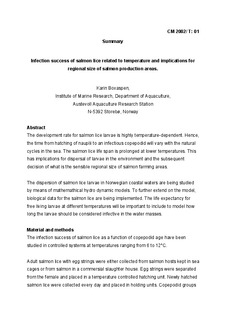| dc.contributor.author | Boxaspen, Karin | |
| dc.date.accessioned | 2012-10-29T19:41:27Z | |
| dc.date.available | 2012-10-29T19:41:27Z | |
| dc.date.issued | 2002 | |
| dc.identifier.citation | This report is not to be cited without prior reference to the author | no_NO |
| dc.identifier.uri | http://hdl.handle.net/11250/106349 | |
| dc.description.abstract | The development rate for salmon lice larvae is highly temperature-dependent. Hence,
the time from hatching of nauplii to an infectious copepodid will vary with the natural
cycles in the sea. The salmon lice life span is prolonged at lower temperatures. This
has implications for dispersal of larvae in the environment and the subsequent
decision of what is the sensible regional size of salmon farming areas.
The dispersion of salmon lice larvae in Norwegian coastal waters are being studied
by means of mathemathical hydro dynamic models. To further extend on the model,
biological data for the salmon lice are being implemented. The life expectancy for
free living larvae at different temperatures will be important to include to model how
long the larvae should be considered infective in the water masses. | no_NO |
| dc.language.iso | eng | no_NO |
| dc.publisher | ICES | no_NO |
| dc.relation.ispartofseries | ICES CM Documents;2002/T:1 | |
| dc.subject | salmon lice | no_NO |
| dc.subject | lakselus | no_NO |
| dc.subject | temperature | no_NO |
| dc.subject | temperatur | no_NO |
| dc.title | Infection success of salmon lice related to temperature and implications for regional size of salmon production areas | no_NO |
| dc.type | Working paper | no_NO |
| dc.subject.nsi | VDP::Agriculture and fishery disciplines: 900::Fisheries science: 920::Resource biology: 921 | no_NO |
| dc.subject.nsi | VDP::Mathematics and natural science: 400::Geosciences: 450::Oceanography: 452 | no_NO |
| dc.subject.nsi | VDP::Agriculture and fishery disciplines: 900::Fisheries science: 920::Fish health: 923 | no_NO |
| dc.source.pagenumber | 2 s. | no_NO |
